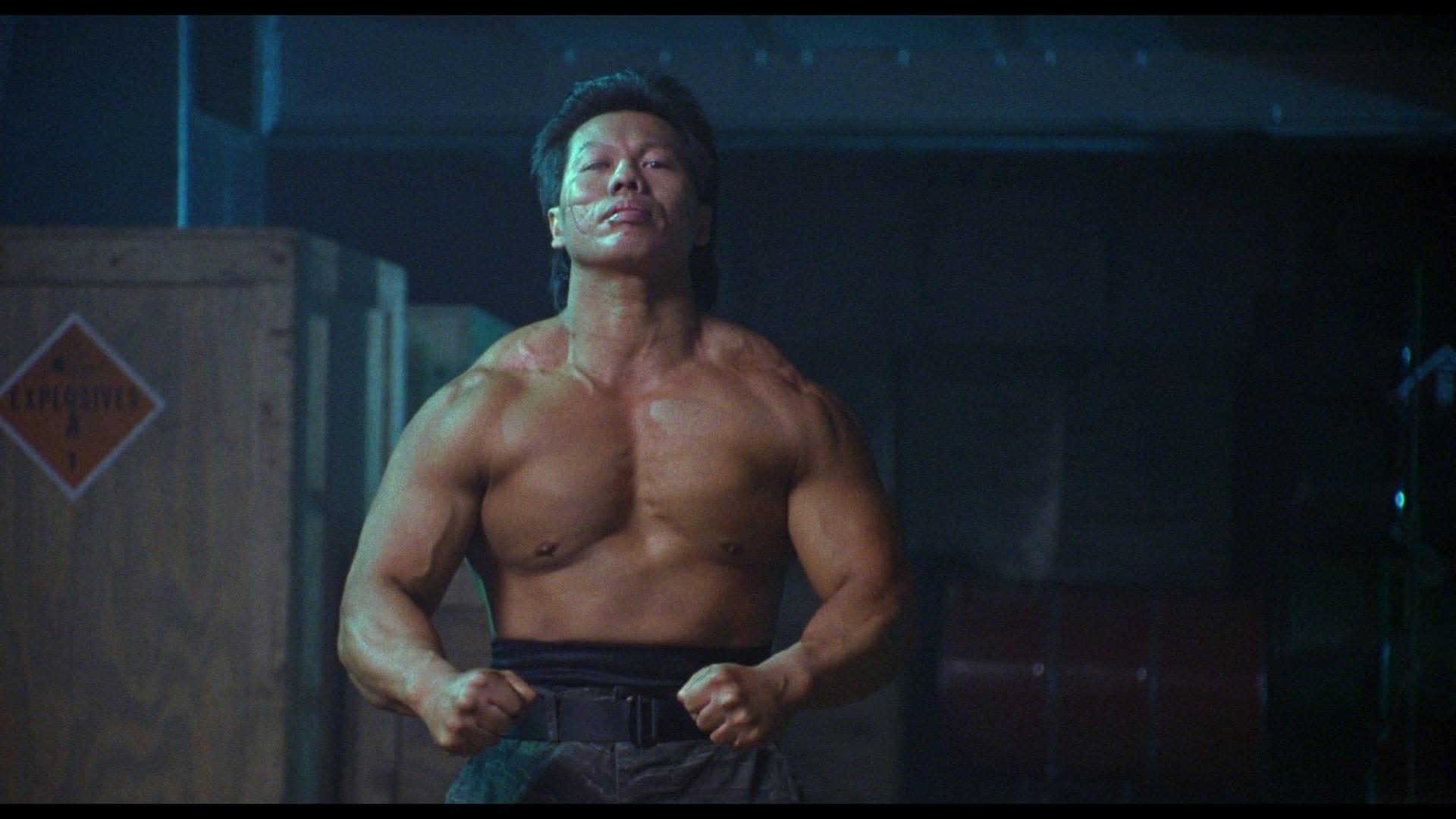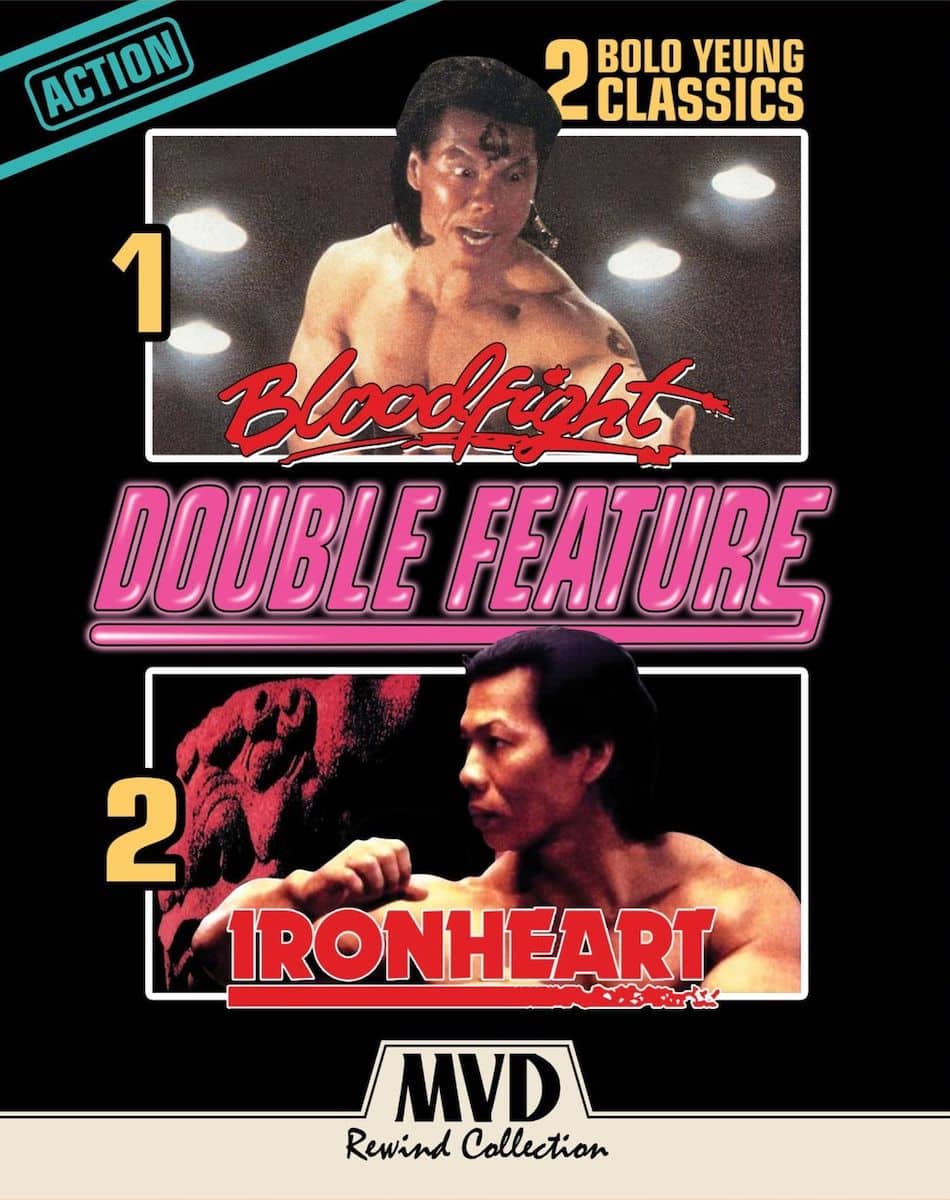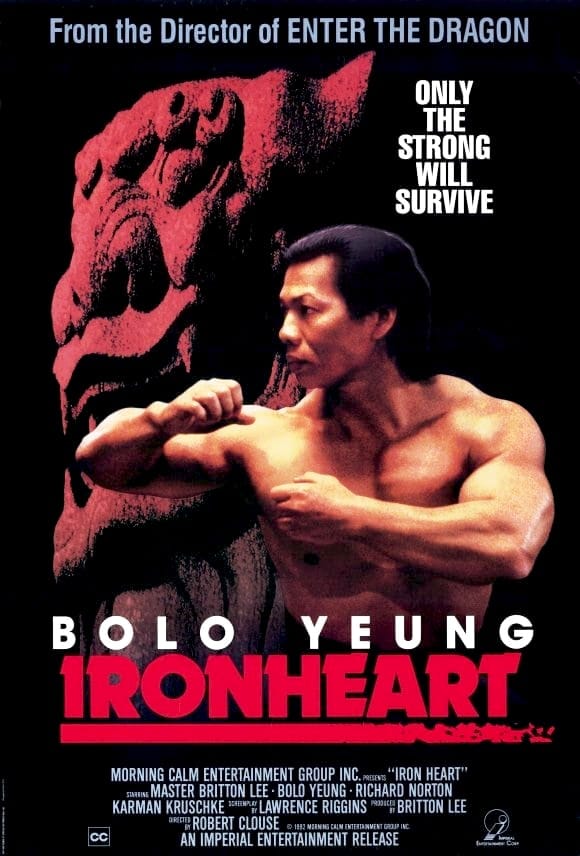Books We're Reading
When Violence is Necessary
"When Violence Is the Answer: Learning How to Do What It Takes When Your Life Is at Stake" by Tim Larkin, a self-protection expert and former military intelligence officer, provides [...]
Share this
It seems peculiar to say, that with as impressive a frame as Bolo Yeung’s, he is somehow a transient figure. Even in his most iconic roles, Bolo has a tendency to silently appear and disappear, as if spliced into films solely for his alternately stoic, explosive or ominous affect. With such mass as his, he should displace everything around him, yet Bolo is agile and often playful, somehow leaving few ripples in the pond.
By virtue of that transience which echoes through 30 years on the screen, and the volume of his often flippant or goading gestures, during Bolo' acting career he has made himself inextricable from the martial arts action film canon and utterly indispensable as the crooked right hand man. With new HD restorations of Double Impact, Enter the Dragon, Bloodfight and Ironheart on the blu ray market, we are suddenly rich in some of Bolo’s best brawls, ripe for a retrospective.
Born Yang Sze in Guangzhou, China in 1946, the now 74 year old former Mr. Hong Kong Bodybuilding Champion carries in perpetuity the name of his breakout role in Robert Clouse’s Enter the Dragon (1973), Bolo. Committing his Kung Fu, Wing Chun and Thai Chi skills to cinematic posterity as he played the role of bad guy after bad guy, the bulk of Bolo’s staggering 111 appearances on film between 1970 and 2017 constitute just that, appearances.
Bolo’s Kung Fu training began at age 10, and as a young adult his dedication to bodybuilding would earn him a physique so imposing he’d be called Hercules. After a treacherous exodus from mainland China to Hong Kong during the calamity of the Cultural Revolution (1966-76), Bolo would find the opportunity he worked so hard for.
His first Mr. Hong Kong Competitive Bodybuilding win in 1970, a title he would own for ten years, coincided with his induction into the film industry, cast in a marathon of minor villainous roles for the Shaw Brothers, predicated largely on the width of his chest and shortness with words gave birth to his acting career.
The expiration of that contract in 1972 would give way to sudden international recognition through Warner Bros. Enter the Dragon, notably the first Martial Arts film produced by an American studio (co-produced with Hong Kong’s Golden Harvest), an opportunity born of Bolo’s friendship with Bruce Lee which was itself a result of his notoriety as Mr. Hong Kong.
In contrast to his warmth and kindness in real life, Bolo’s ferocious turn as that namesake and subsequent loss to John Saxon’s yellow-clad character, Roper, would set in motion a legacy of playing the ill-fated “enforcer”, “henchman” or “final boss” to other insidious masterminds, but sadly almost never the mastermind himself.
In defiance of his stature and swagger, Bolo was also always doomed to lose the last fight, and in far too many instances the fall he takes is a poor measure of his abilities, not to mention his 700+ lb deadlift. However, if we thread these plentiful but fleeting appearances together, the result is one monumental and continuous performance, running like a topstitch through decades of film history, with Bolo taking the fall and getting right back up, over and over again.
Throughout the 70’s Bolo Yeung acting career included being an active stunt coordinator and by decade’s end he would step behind the camera in two directorial efforts, BOLO (1977) and Writing Kung Fu (1979), segueing to a wildly prolific stretch of over 30 screen credits between ’80 and ’89. The late 80’s and early 90’s would yield Bolo’s next international breakout acting roles.

Source: Columbia Pictures, 1991
If Generation-X knew Bolo as synonymous with Bruce Lee, for millennials he is synonymous with Jean Claude Van-Damme. The runaway success of Bloodsport (dir. Newt Arnold, 1989) and Double Impact (dir. Sheldon Lettich, 1991) sees the “Chinese Hercules” and the “Muscles from Brussels” face off in as memorable and reputable a fashion as can be teased out of Bolo’s acting career.
Bolo’s scene stealing turns as Chong Li and Moon respectively cemented all the reasons we love to hate him. MVD Rewind Collection’s recent Bolo Yeung Classics Double-Feature blu-ray helps flesh out some of the martial artist’s post-Bloodsport years with HD transfers of lesser knowns Bloodfight and Ironheart, two performances that feel like variations on Chong Li and Moon.
Given the deliberate bargain-basket aesthetic of this retro film-only edition, Bloodfight and Ironheart function best as artifacts of their time and place, both reading like a style guide for turn-of-the-90’s aesthetic and machismo.
Bloodfight (dir. Shuji Goto 1989) starring Hong Kong cinema royalty Simon Yam (Election, Sparrow) and Yasuaki Kurata (Fist of Legend), feels like a slightly disjointed amalgam of all the kinds of scenes and caricatures one might expect of the underdog fighter genre, but it executes each element with enough potency and exaggeration to distract from their incongruity.
Bearing some resemblances to Bloodsport, Bloodfight is based loosely around a so-called World Free-Fight Tournament which bears a vague resemblance to the original no-weight class, no-holds barred mash-up mania of UFC-1, but comes up slightly short of convincing.
Bolo plays the seemingly unbeatable reigning champion Chang Lee, the kind of dastardly fighter who beats you like a rag doll and then snaps your neck after the bell just for fun. His alternate apathy and mania as Chang Lee mark a volatile performance from Bolo.

Source: MVD Entertainment Group, 2020
Simon Yam is Ryu Tenmei, Sensei Kai’s prospect for defeating Chang Lee, winning back the respect for his destitute gym, and reclaiming his own faded glory. When Ryu loses his life in the ring, Kai plunges into an alcoholic guilt spiral before before he shores up and prepares for a revenge match against Chang Lee.
The more exploitatively tinged Ironheart (1993), a time capsule for the early 90’s Portland Oregon cityscape, re-teams Bolo with director Robert Clause, but we catch only glimpses of the top billed Bolo as Ice, a silent yet smug enforcer to Milverstead (Richard Norton), the smarmy ringleader of an international drug and human trafficking operation.
Bolo mostly paces quietly at Milverstead’s side but satisfies expectations as the final boss. Honestly we could care less about the spineless Milverstead by comparison to Bolo’s delicious cold-bloodedness.
Bolo’s top billing and the use of his image to promote the film is perhaps an affront to the ostensible lead Britton K. Lee as John Keem, a decorated officer out for justice for his fallen ex-partner who was undercover in the Milverstead operation, but Bloodsport had henceforth catapulted Bolo to such bankable heights.
Ironheart marks a paradigm shift in Bolo Yeung’s acting career of happily playing the bad guy. Like the night which is darkest just before dawn, Bolo would play Chong, a sinister serial killer of Martial Artists in Tiger Claws (1991) and Ice in Ironheart before transitioning to roles as the wise teacher for a younger crop. In what might be described as a redemption of character, Bolo takes a subsequent stab at playing the good guy for the better part of the 90’s.
It is unclear as to why Bolo made this shift when he did, but viewed from above, it allowed his acting career to crest as a dramatic arch.

Source: Morning Calm Entertainment Group Inc and Imperial Entertainment, 1992
It is unclear as to why Bolo made this shift when he did, but viewed from above, it allowed his career to crest as a dramatic arch. Still buoyant from the lasting success of Bloodsport, Bolo’s turn to “goodness” gave him the opportunity to play a handful of characters with at least some measure of internal conflict while still at his apex in the public consciousness.
For that reason it was a timely and fruitful decision to render such a contrast. Fans who already loved him (or loved to hate him) for his brutality and swagger could now easily love him for his no-less-badass virtues, and latecomers who only came to know him as this introspective hero could look back and revel in his darker episodes.
The reality is that being “good” didn’t require more from Bolo, but seemingly less. As a result, even his reprisal of the sinister Chong in Tiger Claws II in 1996 sees a more patient, contemplative, if not subtle expression from Bolo, one that inflames the imagination of his possibly untapped talents.
Bolo’s turn as Sensei Shingo in the direct-to-video features Shoot Fighter: Fight to the Death (1993) and Shoot Fighter 2 (1996), and Master Sumai in TC 2000 (1993) constitute the lion’s share of virtuous moments and incidentally some of the handsomest production values of Bolo’s extensive oeuvre, albeit among his final screen work.
With only two film credits since the turn of the century, Bolo Yeung may be ostensibly retired from film, but the Criterion Collection and MVD Rewind have done a venerable job of putting the spotlight back on a living legend. We are hungry for more.
Want more? Check out other posts on What We're Watching.
Post main image courtesy of Warner Bros. and Golden Harvest, 1973
Loved this? Spread the word
Books We're Reading
"When Violence Is the Answer: Learning How to Do What It Takes When Your Life Is at Stake" by Tim Larkin, a self-protection expert and former military intelligence officer, provides [...]
Staff Reviews
Feed Me Fight Me is all about the Mission. For John Watkins and Brian Eayrs, who became friends while serving in the US Marine CORPS, their burgeoning business’ mission is a [...]
Oceania, Where We're Headed
Megan Anderson fears no woman. Even with a scheduled December bout against Amanda Nunes — a two-division UFC champion that napalms faces for a living — a dauntless Megan Anderson [...]
Strength and Conditioning Posts
How badly do you want it? I mean really want it? This is a question I've asked myself countless times throughout my martial arts journey. Because true mastery is attainable—but [...]
Movies We're Watching
By all rights, Alber Pyun’s Nemesis (1992) should be a staple midnight movie, slated alongside the likes of Eraserhead, Mad Max, and Faster Pussycat, Kill Kill! At that rate, his [...]
Workout Recovery Posts
Recovery techniques cover many bases. You do not want to wait until you are injured to start thinking about it. In fact, using proactive or preemptive recovery methods daily is [...]
Americas, Where We're Headed
Imagine the sport of Mixed Martial Arts is a house.The foundation is the rules, the walls and floors are the fighters, and the roof is the promoters. Maybe, the doorbell [...]
Africa, Where We're Headed
Egypt is home to one of the world’s earliest civilizations. The country has seven UNESCO World Heritage sites. There’s hardly anyone in the world who doesn’t know about Egyptian pharaohs [...]
Nutrition Posts
One of the primary ingredients in Dit Da Jow, fennel seeds are healthy and have massive health benefits that can help prepare you for a fight, may prevent bruising, and [...]
Middle East, Where We're Headed
The Kingdom of Saudi Arabia has been making news for opening its borders for recreational tourism. Until 2018, it issued visas only for pilgrimages, business matters, sports events, and foreign [...]
Europe, Where We're Headed
The European Budo Centre - Dojo Stara Wieś is an architectural gem nestled within the picturesque Polish landscape. This facility is designed and built according to the principles of Japanese [...]
Far East, Where We're Headed
Renowned as the queen of the South, Cebu is the port capital and the oldest city in Cebu province. Located in the Central Visayas, it’s the country’s most developed area, [...]
Stuff We're Learning
As you enter any traditional dojo around the world, one of the first customs you'll encounter is the formal bow—a gesture that transcends language, culture, and fighting style. This seemingly [...]
Injury Management Posts
In June 2021, the world watched in horror as Danish footballer Christian Eriksen suffered a sudden cardiac arrest during a Euro 2020 match. This shocking incident highlighted the importance of [...]
Session expired
Please log in again. The login page will open in a new tab. After logging in you can close it and return to this page.